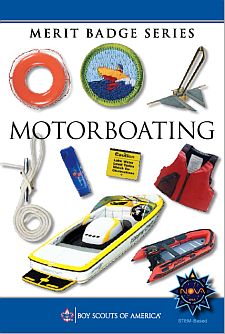- Do the following:
- Explain to your counselor the most likely hazards you may encounter while motorboating, and what you should do to anticipate, help prevent, mitigate, and respond to these hazards.
- Explain first aid for injuries or illnesses that could occur while motorboating, including hypothermia, heat reactions, dehydration, motion sickness, bugbites, and blisters.
- Identify the conditions that must exist before performing CPR on a person, and explain how such conditions are recognized. Demonstrate proper technique for performing CPR using a training device approved by your counselor.
- Do the following:
- Before doing requirements 3 through 6, successfully complete the BSA swimmer test.
- Name the different types of personal floatation devices (PFDs), and explain when each type should be used. Show how to choose and properly fit a PFD.
- Do the following:
- Explain inboard, outboard, and inboard/outboard motors and the uses and advantages of each. Discuss the special features of a bass boat and a ski boat.
- Explain the safety procedures and precautions involving handling fuel and engine servicing, and equipment storage and placement.
- Explain how to winterize a boat motor and tell why this procedure is necessary.
- Explain the safety procedures and precautions involving swimmers and skiers in the water, passenger positions underway, and boat wakes.
- Show you know safety laws for motorboating by doing the following:
- Have a permit to run a motorboat, if needed.
- Explain the rules or laws that apply to recreational boating in your area or state.
- Discuss how the hazards of weather and heavy water conditions can affect both safety and performance in motorboating.
- Promise that you will follow BSA Safety Afloat guidelines. Explain the meaning of each point.
- Discuss with your counselor the nautical rules of the road and describe the national and your state's aids to navigation.
- Explain and show the correct use of equipment required by both state and federal regulations to be carried aboard a motorboat.
- Explain federal and state rules for a ventilation system, and tell why these rules are required.
- Explain the use of lights (sight signals) and sound signals on motorboats.
- Discuss the common types of anchors used in motorboating and under what conditions each would be preferred. Explain proper anchoring techniques.
- With your counselor or other adults on board, demonstrate proper
boat-handling procedures and skills by doing the following:
- Board and assist others in boarding
- Fuel the boat and complete a safety check.
- Get under way from dockside or from a beach launch.
- Run a course for at least a mile, showing procedures for overtaking and passing slower craft, yielding right-of-way, passing oncoming traffic, making turns, reversing direction, and using navigation aids.
- Stop and secure the boat in position on the open water using anchors.Raise and stow the anchor and get underway.
- Land or dock the boat, disembark, and assist others in doing the same.
- Moor, dock, or beach the boat and secure all gear.
(footnotes)
BSA Advancement ID#:
76
Requirements last updated in:
2019
Pamphlet Stock Number:
35920
Pamphlet SKU Number:
618651
Pamphlet Revision Date:
2016
|
|||||||
Page updated on: May 08, 2022









